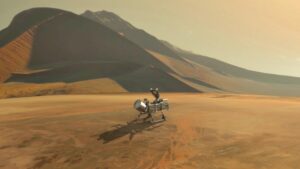NASA to delay next New Frontiers competition
By Jeff Foust

WASHINGTON — NASA will delay the next call for proposals for the New Frontiers program of planetary science missions by two years, a move that could also change what missions will be eligible to compete.
In a May 12 statement, NASA said it was postponing the release of the announcement of opportunity (AO) for the fifth New Frontiers mission. NASA had planned to release a draft version of that AO in October, with the final version released a year later. The agency said the draft AO will now be released in October 2023, and the final version in October 2024. Proposals will be due to NASA 90 days after the release of the final AO.
“While there had been plans to begin the proposal cycle in 2022, the delays are driven by other missions being in peak development and COVID-related challenges in the broader Planetary Science Division portfolio,” the agency said in a brief statement about the postponement.
In a separate message to the planetary science community, NASA said its decision to postpone the launch of the fourth New Frontiers mission, Dragonfly, from 2026 to 2027, contributed to the decision to postpone the AO for the next New Frontiers mission. NASA said in September that it postponed the launch because of factors unrelated to the mission itself, such as broader pressures on NASA’s planetary science budget caused by the pandemic.
“It was purely a headquarters decision to address some of the cost phasing challenges that we have,” Lori Glaze, director of NASA’s planetary science division, said of the Dragonfly delay at a meeting of the Outer Planets Assessment Group (OPAG) in February.
The delay in the next New Frontiers competition is intended to keep that mission’s budget from overlapping with Dragonfly. “The updated AO schedule estimate allows selection of the fifth New Frontiers mission at around the time of Dragonfly’s launch, thereby avoiding the budget strain of having two New Frontiers missions in development at the same time,” NASA said in its message to the science community.
At various meetings earlier this year, Glaze and other NASA officials offered no indications that the New Frontiers AO would be delayed. At a NASA town hall meeting March 18 during the Lunar and Planetary Sciences Conference, Glaze said NASA was preparing to hold a “community town hall” in the spring about the New Frontiers AO to provide “more information about what we expect to go into the draft AO, which will be released in the fall.”
The two-year delay in the next New Frontiers competition, though, has consequences beyond schedule. Unlike the Discovery program of lower-cost planetary science missions, which is open to nearly all solar system destinations beyond Earth, New Frontiers is limited to a handful of potential destinations and mission types, based on guidance from the planetary science decadal survey.
NASA had not finalized the list of “mission themes” for the New Frontiers 5 AO as of earlier this year. Among those considered were a comet surface sample return mission, a mission to Jupiter’s volcanic moon Io, a lunar geophysical network, a sample return mission to the moon’s South Pole-Aitken Basin, a Saturn probe, a mission to Saturn’s icy moon Enceladus and a Venus orbiter.
In a presentation at the OPAG meeting in February, NASA’s Curt Niebur said that list of mission themes would depend on other factors, such as the outcome of an ongoing Discovery competition, where NASA will select up to two missions this summer. The inclusion of a lunar sample return mission would also depend on selection of landing sites for NASA’s Artemis human lunar exploration program.
However, the National Academies is currently working on a new planetary science decadal survey, due to be released in the spring of 2022. That could provide a new list of potential destinations for New Frontiers missions different from the one NASA had been considering, upending planning that was already underway under the original schedule.
“The new AO release date places the fifth New Frontiers mission firmly in the time period being deliberated upon by the ongoing planetary science decadal survey,” NASA said in its notice to scientists. The agency, it added, “intends to use the results of this decadal survey, expected in early 2022, to guide the New Frontiers 5 AO.”
The decadal survey, though, is not the only factor in determining the list of potential New Frontiers mission themes. Before NASA held the competition for the fourth New Frontiers mission, it added an “Ocean Worlds” theme in response to congressional direction to create an “Ocean Worlds Exploration Program” that included Jupiter’s moon Europa and Saturn’s Enceladus and Titan. That allowed the Dragonfly mission, a drone that will fly in Titan’s atmosphere, to compete and be selected for development.
May 19, 2021 at 04:25AM
via SpaceNews read more...

Post a Comment